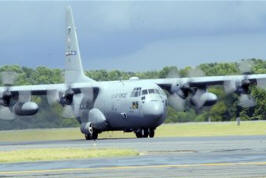
NEWSROOM
 |
NEWSROOM |
|
|
|
|
|||
|
Airmen Deploy To |
||||
 |
January 14 2010 -
On Tuesday a major earthquake hit the
President Obama
has stated he has directed his administration to respond with a swift,
coordinated, and aggressive effort to save lives.
“The people of Haiti will have the full support of the United
States in the urgent effort to rescue those trapped beneath the rubble,
and to deliver the humanitarian relief -- the food, water and medicine
-- that Haitians will need in the coming days.
In that effort, our government, especially USAID and the
Departments of State and Defense are working closely together and with
our partners in
U.S. Southern
Command officials have deployed a team of 30 people to |
|||
| A C-130 Hercules, similar to this one, took off Jan. 13, 2010, with a team of U.S. Southern Command officials from Miami to Haiti to support U.S. relief efforts in the aftermath of the Jan. 12, 2010, 7.0 magnitude earthquake. The team, which includes U.S. military engineers, operational planners, and a command and control group and communication specialists arrive on two Air Force C-130s. | ||||
|
The team will work with U.S. Embassy officials as well as Haitian,
United Nations and international officials to assess the situation and
facilitate follow on
A Navy P-3 Orion aircraft from the Forward Operating Location at
Comalapa, El Salvador, took off early
Wednesday to conduct an aerial reconnaissance of the area
affected by the earthquake. |
||||
|
An earthquake (also known as a tremor or temblor) is the result of a sudden release of energy in the Earth's crust that creates seismic waves. Earthquakes are recorded with a seismometer, also known as a seismograph. The moment magnitude (or the related and mostly obsolete Richter magnitude) of an earthquake is conventionally reported, with magnitude 3 or lower earthquakes being mostly imperceptible and magnitude 7 causing serious damage over large areas. At the Earth's surface, earthquakes manifest themselves by shaking and sometimes displacing the ground. When a large earthquake epicenter is located offshore, the seabed sometimes suffers sufficient displacement to cause a tsunami. The shaking in earthquakes can
also trigger landslides and occasionally volcanic activity. |
| ©AvStop Online Magazine Contact Us Return To News |
|